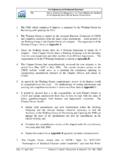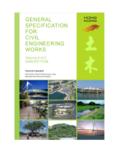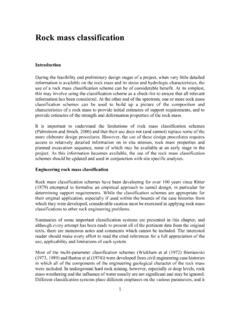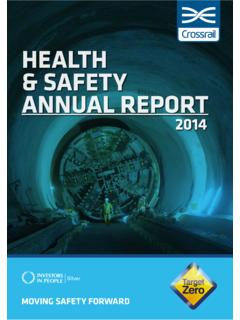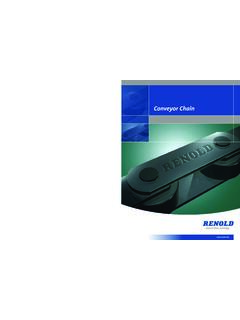Transcription of GUIDETO SOIL NAIL DESIGN AND CONSTRUCTION
1 GEOGUIDE7 GUIDETOSOIL NAIL DESIGN AND CONSTRUCTIONGEOTECHNICALENGINEERINGOFFIC EC ivil Engineering and Development Department TheGovernmentoftheHongKongSpecialAdminis trativeRegion GEOGUIDE 7 GUIDE TO SOIL NAIL DESIGN AND CONSTRUCTION GEOTECHNICAL ENGINEERING OFFICE Civil Engineering and Development Department The Government of the Hong Kong Special Administrative Region 2 The Government of the Hong Kong Special Administrative Region First published, March 2008 Prepared by: Geotechnical Engineering Office, Civil Engineering and Development Department, Civil Engineering and Development Building, 101 Princess Margaret Road, Homantin, Kowloon, Hong Kong.
2 3 FOREWORD This Geoguide presents a recommended standard of good practice for the DESIGN , CONSTRUCTION , monitoring and maintenance of soil-nailed systems in Hong Kong. The Geoguide summarises the experience gained from the use of the soil nailing technique in Hong Kong and the findings of related technical development work. The recommended good practice set out in this Geoguide primarily covers the use of high yield deformed steel bars installed by the drill-and-grout method for reinforcing slopes, retaining walls and excavations. The compilation of this Geoguide was supported by a series of soil nail related studies initiated by the Geotechnical Engineering Office (GEO), researchers and practitioners, which facilitated development of systematic guidelines on DESIGN and CONSTRUCTION to enhance the reliability of soil-nailed systems.
3 The studies included literature reviews, field tests, laboratory investigations and numerical modelling. Some of the findings have already been presented in technical publications and promulgated in GEO reports and technical guidance notes. The preparation of this Geoguide was overseen by a Working Group. The membership of the Working Group, given on the next page, included representatives from relevant government works departments, the Hong Kong Institution of Engineers (Geotechnical Division) and Landslip Preventive Measures (LPM) Contractors. The Management Committee of the GEO provided overall steering to the preparation of the Geoguide. To ensure that the Geoguide would be accepted as a consensus document by interested parties in Hong Kong, a draft version was circulated locally and abroad for comment in late 2007.
4 Those consulted included professional bodies, consulting engineers, contractors, academics and government departments. The document was also posted on the website of the Civil Engineering and Development Department for public comment. Many individuals and organisations made useful comments, which have been taken into account in finalising this Geoguide. All contributions are gratefully acknowledged. As with other Geoguides, this document gives guidance on good engineering practice, and its recommendations are not intended to be mandatory. As experience and good practice evolve, practitioners are encouraged to provide comments to the Geotechnical Engineering Office at any time on the contents of this Geoguide, so that improvements can be made to future editions. Chan Head, Geotechnical Engineering Office Civil Engineering and Development Department March 2008 4 WORKING GROUP : Architectural Services Department Mr.
5 Joseph Wong Civil Engineering and Development Department Mr. Pun (Chairman) Mr. Herman Shiu Mr. Charles Chan Mr. Stephen Yip Mr. Choi Mr. Lawrence Shum Dr. Raymond Cheung (Secretary) Highways Department Mr. Andy Wong Housing Department Mr. Raymond Wong LPM Contractors Mr. Cheung The Hong Kong Institution of Engineers (Geotechnical Division) Dr. Eric Li 5 CONTENTS Page No. TITLE PAGE 1 FOREWORD 3 CONTENTS 5 LIST OF TABLES 9 LIST OF FIGURES 10 1. introduction 13 PURPOSE AND SCOPE 13 2. APPLICATIONS 15 GENERAL 15 DEVELOPMENT OF THE SOIL NAILING TECHNIQUE 15 AREAS OF APPLICATION 15 FUNDAMENTALS OF A SOIL-NAILED SYSTEM 16 Installation Methods 16 Basic Elements of a Soil-nailed System 17 MERITS AND LIMITATIONS 19 3.
6 PRINCIPLES OF A SOIL-NAILED SYSTEM 21 GENERAL 21 CLASSIFICATION OF A SOIL-NAILED SYSTEM 21 FUNDAMENTAL MECHANISM OF A SOIL-NAILED SYSTEM 21 6 Page No. NAIL-GROUND INTERACTION 22 4. SITE INVESTIGATION AND TESTING 27 GENERAL 27 BUILDABILITY OF SOIL NAILS 27 DURABILITY OF SOIL NAILS 29 General 29 Soil Aggressivity 29 Soil Aggressivity Assessment 30 5. DESIGN OF A SOIL-NAILED SYSTEM 33 GENERAL 33 DESIGN CONSIDERATIONS 33 DESIGN FOR STABILITY 34 General 34 Modes of Failure 34 Models 36 Methods of Stability Analysis 37 DESIGN FOR SERVICEABILITY 37 DESIGN FOR DURABILITY 38 ANALYTICAL DESIGN OF SOIL NAILS IN SOIL CUT SLOPES 40 General 40 Factor of Safety 40 Soil-nail Reinforcement 43 Soil-nail Head 46 Slope Facing 48 ANALYTICAL DESIGN OF SOIL NAILS IN RETAINING WALLS 50
7 General 50 Factor of Safety 51 Soil-nail Reinforcement 52 Soil-nail Head and Facing 52 ANALYTICAL DESIGN OF SOIL NAILS IN FILL SLOPES 56 General 56 7 Page No. Factor of Safety 56 DESIGN against Liquefaction 57 Soil-nail Reinforcement 58 PRESCRIPTIVE DESIGN OF SOIL NAILS IN EXISTING 58 SOIL CUT SLOPES AND RETAINING WALLS DRAINAGE PROVISION 59 AESTHETICS AND LANDSCAPE TREATMENT 60 DESIGN OF SOIL NAILS IN SPECIFIC CIRCUMSTANCES 61 General 61 DESIGN of Soil Nails Carrying Sustained Loads 63 DESIGN of Soil Nails in Temporary Excavations 64 DESIGN of Soil Nails using Alternative Reinforcement 64 Materials 6.
8 CONSTRUCTION 67 GENERAL 67 CONSTRUCTION SUPERVISION AND CONSIDERATIONS 67 General 67 Drilling 68 Installation of Soil-nail Reinforcement 73 Grouting 73 CONSTRUCTION of Soil-nail Heads 74 Excavation Sequence 74 TESTING 75 Material Compliance Testing 75 Pullout Test 75 Creep Test 77 Non-destructive Testing 77 Destructive Testing 79 7.
9 MONITORING AND MAINTENANCE 81 GENERAL 81 MONITORING 81 MAINTENANCE 81 8 Page No. REFERENCES 83 GLOSSARY OF SYMBOLS 87 GLOSSARY OF TERMS 93 9 LIST OF TABLES Table No. Page No. Classification of Soil Aggressivity 30 Soil Aggressivity Assessment Scheme 31 Recommended Corrosion Protection Measures for Soil Nails Carrying Transient Loads 39 Typical Examples of Slope Failures in Each Consequence-to-life Category 41 Typical Examples of Slope Failures in Each Economic Consequence Category 41 Recommended Minimum Factor of Safety against Failure for New Soil-nailed Cut Slopes for a Ten-year Return Period Rainfall 42 Recommended Minimum Factor of Safety against Failure for Existing Cut Slopes Upgraded by Soil Nails for a Ten-year Return Period Rainfall 42 Recommended Minimum Factor of Safety against Internal Failure of a Soil Nail
10 42 Recommended Sizes of Isolated Soil-nail Heads 46 Recommended Minimum Factor of Safety against External Failure for Existing Retaining Walls Upgraded by Soil Nails for a Ten-year Return Period Rainfall 51 Recommended Corrosion Protection Measures for Soil Nails Carrying Sustained Loads 63 10 LIST OF FIGURES Figure No. Page No. Schematic Diagram of a Soil-nailed Cut Slope 18 Two-zone Model of a Soil-nailed System 22 Effect of Soil-nail Inclination on the Mobilisation of Force in a Soil Nail 23 Effect of Reinforcement Orientation on the Increase in Shear Strength of Reinforced Soil 24 Schematic Distribution of Tensile Forces along Soil Nails 25 Potential External Failure Modes of a Soil-nailed System 34 Potential Internal Failure Modes of a Soil-nailed System 35 Typical Details of Class 1 Corrosion Protection Measures 39 Soil-nail Head DESIGN Method Recommended by the UK Department of Transport 47 Typical Reinforcement Details of a







